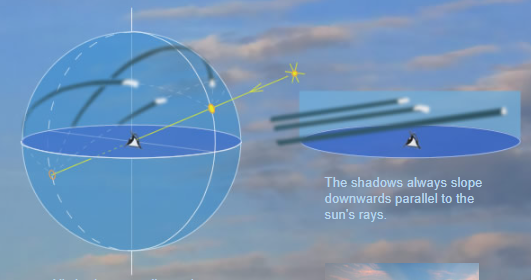Antisolar (crepuscular) rays, Cornwall, England - OPOD
Antisolar (Crepuscular) Rays: A Phenomenon in the Skies of Cornwall, England
Have you ever gazed at the sky during a sunset and noticed faint, dark beams converging towards a point below the horizon, opposite to the sun? These intriguing celestial phenomena are known as antisolar rays, or more commonly referred to as anticrepuscular rays. While they may appear subtle and elusive, they are actually a frequent occurrence in the skies above Cornwall, England.
Antisolar rays, captured in a stunning photograph by Chris Morton, exhibit a customary appearance that is both faint and hinting. They seem to shift and change as if playing hide-and-seek with the observer. Although often underestimated, these atmospheric optics phenomena are more prevalent than one might think.
The captivating image taken by Chris Morton showcases the customary subtlety of antisolar rays. These rays manifest as long shadows that traverse the sky from sunward clouds. As the shadows extend towards the antisolar point, they darken, creating a mesmerizing visual effect that captures the imagination of skywatchers.
To better understand the nature of antisolar rays, it is important to observe their characteristics and behavior. Here are some key points to consider:
-
Convergence: The dark beams of antisolar rays appear to converge as they extend further into the distance. This convergence adds to their mystique and allure, drawing observers into their captivating beauty.
-
Shadow Length: The shadows cast by antisolar rays darken towards the antisolar point because the eye is looking along a greater length of the shadow pipe. This phenomenon creates a gradient of darkness that adds depth and dimension to the overall visual display.
-
Slope and Direction: The shadows of antisolar rays always slope downwards parallel to the sun's rays. This alignment creates a sense of harmony and symmetry in the sky, enhancing the overall aesthetic appeal of these atmospheric phenomena.
While the existing content provides a brief introduction to antisolar rays, let's delve deeper into the intricacies of this captivating celestial display. Here are some additional insights and details:
-
Occurrence and Frequency: Antisolar rays are not exclusive to Cornwall, England. They can be observed in various locations worldwide, depending on the atmospheric conditions and the position of the sun. However, due to its unique geography and atmospheric dynamics, Cornwall offers a particularly favorable environment for observing these rays.
-
Atmospheric Optics: Antisolar rays are a fascinating example of atmospheric optics, which involve the study of how light interacts with the Earth's atmosphere to create optical phenomena. Understanding the underlying physics behind these phenomena can deepen our appreciation for the wonders of nature and the play of light in the sky.
-
Formation Mechanism: The formation of antisolar rays is intricately linked to the scattering and absorption of sunlight by tiny particles, such as dust, water droplets, or ice crystals, present in the atmosphere. These particles act as miniature prisms, refracting and redirecting sunlight to create the shadowy beams that we observe.
-
Time of Day: Antisolar rays are most commonly seen during sunrise or sunset when the sun is low on the horizon. The angle at which sunlight interacts with the atmosphere during these times enhances the visibility of these rays, making them more pronounced and awe-inspiring.
-
Photographic Opportunities: Capturing the beauty of antisolar rays through photography can be a rewarding endeavor. By using appropriate camera settings and techniques, photographers can immortalize these ethereal phenomena, allowing others to marvel at their splendor even after they fade from the sky.
In conclusion, antisolar rays are a captivating celestial spectacle that grace the skies of Cornwall, England and many other locations around the world. Their subtle yet mesmerizing appearance adds a touch of magic to our daily encounters with the natural world. By understanding the underlying physics and observing their behavior, we can unlock a deeper appreciation for the wonders of atmospheric optics and the ever-changing canvas of the sky. So, the next time you find yourself witnessing a breathtaking sunset, remember to cast your gaze towards the opposite horizon, for there, you might just catch a glimpse of the elusive antisolar rays dancing in the heavens above.

Antisolar Rays
Chris Morton looked east near sunset from Cornwall, England.
Faint dark beams converge towards a point below the horizon and opposite the sun. They are anticrepuscular rays or better called antisolar rays, long shadows that traverse the sky from sunward clouds.
This view conveys well their customary subtle appearance, faint, hinting, elusive, shifting. They are there more oft than is thought.
Image ©Chris Morton, shown with permission

All shadows are directed to the antisolar point.
They appear to converge as the get more distant.
They darken towards the antisolar point because the eye is looking along a greater length of the shadow pipe.
The shadows always slope downwards parallel to the sun's rays.
Note: this article has been automatically converted from the old site and may not appear as intended. You can find the original article here.
Reference Atmospheric Optics
If you use any of the definitions, information, or data presented on Atmospheric Optics, please copy the link or reference below to properly credit us as the reference source. Thank you!
-
<a href="https://atoptics.co.uk/blog/antisolar-crepuscular-rays-cornwall-england-opod/">Antisolar (crepuscular) rays, Cornwall, England - OPOD</a>
-
"Antisolar (crepuscular) rays, Cornwall, England - OPOD". Atmospheric Optics. Accessed on November 26, 2024. https://atoptics.co.uk/blog/antisolar-crepuscular-rays-cornwall-england-opod/.
-
"Antisolar (crepuscular) rays, Cornwall, England - OPOD". Atmospheric Optics, https://atoptics.co.uk/blog/antisolar-crepuscular-rays-cornwall-england-opod/. Accessed 26 November, 2024
-
Antisolar (crepuscular) rays, Cornwall, England - OPOD. Atmospheric Optics. Retrieved from https://atoptics.co.uk/blog/antisolar-crepuscular-rays-cornwall-england-opod/.